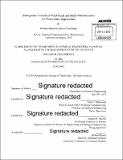Biologically-templated metal oxide and metal nanostructures for photovoltaic applications
Author(s)
Dorval Courchesne, Noémie-Manuelle
DownloadFull printable version (48.56Mb)
Other Contributors
Massachusetts Institute of Technology. Department of Chemical Engineering.
Advisor
Paula T. Hammond and Angela M. Belcher.
Terms of use
Metadata
Show full item recordAbstract
In several electronic, electrochemical and photonic systems, the organization of materials at the nanoscale is critical. Specifically, in nanostructured heterojunction solar cells, active materials with high surface area and continuous shapes tend to improve charge transport and collection, and to minimize recombination. Organizing nanoparticles, quantum dots or organic molecules intro three-dimensional structures can thus improve device efficiency. To do so, biotemplates with a wide variety of shapes and length scales can be used to nucleate nanoparticles and to organize them into complex structures. In this work, we have used microorganisms as templates to assemble metal oxide and metal nano- and microstructures that can enhance the performance of photovoltaic devices. First, we used M13 bacteriophages for their high aspect ratio and ability to bind noble metal nanoparticles, to create plasmonic nanowire arrays. We developed a novel process to assemble bacteriophages into nanoporous thin films via layer-by-layer assembly, and we mineralized the structure with titania. The resulting porous titania network was infiltrated with lead sulfide quantum dots to construct functional solar cells. We then used this system as a platform to study the effects of morphology and plasmonics on device performance, and observed significant improvements in photocurrent for devices containing bacteriophages. Next, we developed a process to magnesiothermally reduce biotemplated and solution-processed metal oxide structures into useful metallic materials that cannot be otherwise synthesized in solution. We applied the process to the synthesis of silicon nanostructures for use as semiconductors or photoactive materials. As starting materials, we obtained diatomaceous earth, a natural source of biotemplated silica, and we also mineralized M13 bacteriophages with silica to produce porous nanonetworks, and Spirulina major, a spiral-shaped algae, to produce micro-coils. We successfully reduced all silica structures to nanocrystalline silicon while preserving their shape. Overall, this work provides insights into incorporating biological materials in energy-related devices, doping materials to create semiconductors, characterizing their morphology and composition, and measuring their performance. The versatility and simplicity of the bottom-up assembly processes described here could contribute to the production of more accessible and inexpensive nanostructured energy conversion devices.
Description
Thesis: Ph. D., Massachusetts Institute of Technology, Department of Chemical Engineering, 2015. Cataloged from PDF version of thesis. Vita. Page 296 blank. Includes bibliographical references.
Date issued
2015Department
Massachusetts Institute of Technology. Department of Chemical EngineeringPublisher
Massachusetts Institute of Technology
Keywords
Chemical Engineering.